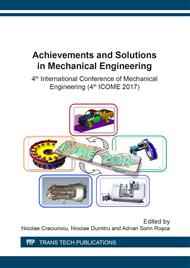[1]
S.A. England, K. P Granata, The influence of gait speed on local dynamic stability of walking. Gait and Posture, 25 (2007) 172–178.
DOI: 10.1016/j.gaitpost.2006.03.003
Google Scholar
[2]
J.M. Hausdorff, Gait dynamics, fractals and falls: finding meaning in the stride to-stride fluctuations of human walking, Human Movement Science 26(4), (2007) 555–589.
DOI: 10.1016/j.humov.2007.05.003
Google Scholar
[3]
J.B. Dingwell, L.C. Marin, Kinematic variability and local dynamic stability of upper body motions when walking at different speeds, J Biomech, 39 (2006) 444–452.
DOI: 10.1016/j.jbiomech.2004.12.014
Google Scholar
[4]
D. Tarniţă, I. Geonea, et al, Experimental Characterization of Human Walking on Stairs Applied to Humanoid Dynamics, Advances in Robot Design and Intellig Control, Springer, (2017) 293-301.
DOI: 10.1007/978-3-319-49058-8_32
Google Scholar
[5]
D. Tarniţă, M Catana, et al., Nonlinear Analysis of Normal Human Gait for Different Activities with Application to Bipedal Locomotion, Ro. J. Tech. Sci. Appl. Mech., 58, (2013) 177–192.
Google Scholar
[6]
R. Hegger, H. Kantz, T. Schreiber, Practical implementation of nonlinear time series methods: The TISEAN package, Chaos: An Interdisciplinary Journal of Nonlinear Science, 9 (1999) 9-413.
DOI: 10.1063/1.166424
Google Scholar
[7]
D. Tarniţă, Wearable sensors used for human gait analysis, Rom J Morphol Embryol 57(2) (2016) 373-382.
Google Scholar
[8]
D. Tarniţă, I. Geonea, et al, Numerical Simulations and Experimental Human Gait Analysis Using Wearable Sensors, New Trends in Medical and Service Robots, Springer (2017) 289-304.
DOI: 10.1007/978-3-319-59972-4_21
Google Scholar
[9]
F. Takens, Detecting strange attractors in fluid turbulence, Dynamical Syst Turbulence, Springer Berlin (1981) 366–381.
DOI: 10.1007/bfb0091924
Google Scholar
[10]
D. S. Broomhead, G. P. King. Extracting qualitative dynamics from experimental data, Physica D. 20 (1986) 217 – 236.
DOI: 10.1016/0167-2789(86)90031-x
Google Scholar
[11]
E. Bradley, H. Kantz, Nonlinear time-series analysis revisited Chaos, 25(9) (2015).
Google Scholar
[12]
H. Kantz, T. Schreiber, Nonlinear Time series Analysis, Cambridge university press, (1996).
Google Scholar
[13]
A.M. Fraser, H.L. Swinney, Independent coordinates for strange attractors from mutual information, PhysRev A 33 (1986) 1134–1140.
DOI: 10.1103/physreva.33.1134
Google Scholar
[14]
H.A. Sturges, The choice of a class interval, Journ of the American Statist Assoc (1926) 65–66.
Google Scholar
[15]
M.B. Kennel, R. Brown, H. D. I. Abarbanel, Determining minimum embedding dimension using a geometrical construction, Phys. Rev. A 45 (1992) 3403–3411.
DOI: 10.1103/physreva.45.3403
Google Scholar
[16]
J.B. Dingwell, J.P. et al, Local dynamic stability versus kinematic variability of continuous overground and treadmill walking, J Biomech Eng Transact ASME 123 (2001) 27–32.
DOI: 10.1115/1.1336798
Google Scholar
[17]
M.T. Rosenstein, I.J. Collins, C.J. Deluca, A practical method for calculating largest Lyapunov exponents from small data sets, Phys D, 65 (1993) 117–134.
DOI: 10.1016/0167-2789(93)90009-p
Google Scholar
[18]
D. Tarniţă, M. Georgescu, et. al, Applications of Nonlinear Dynamics to Gait Analysis on Plane & Inclined Treadmill, New Trends in Medical and Service Robots, Springer 39 (2016) 59-73.
Google Scholar
[19]
M. Georgescu, A. Petcu, D. Tarniţă. Nonlinear movement of human knee overground & on treadmill, Bulletin of the Transilvania University of Brasov, 9 . 58 (2016) 125-132.
Google Scholar


